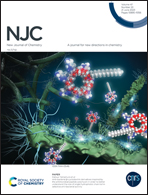Underwater superoleophobic PVDF membrane with robust stability for highly efficient oil-in-water emulsion separation
Abstract
Membrane technology greatly boosts the quick collection process of clean-water from oily wastewater. Although a great amount of research has been devoted to fabricating super wetting membranes to efficiently separate waste oil/water mixtures, the environmental friendliness of the membrane and the durable separation performance of the membrane have still obstructed the development of this field. Preparing a kind of membrane with environmental friendliness and excellent antifouling properties is therefore necessary. Herein, a kind of underwater superoleophobic polyethylene glycol (PEG) grafted polyvinylidene fluoride (PVDF) membrane (PPG membrane) was fabricated through a simple, environmentally friendly and energy-saving surface grafting method by activating PVDF membrane with aminopropyltriethoxysilane (APTES) and then grafting PEG on its surface. The PPG membrane could efficiently separate various kinds of oil-in-water emulsions even including high-viscosity crude oil, and a separation efficiency up to 99.6% as well as a permeation flux of 1130 L m−2 h−1 are reached. Moreover, the as-prepared PPG membrane displayed excellent mechanical and chemical stabilities after the mechanical test (100 times of abrasion) and chemical test (soaking in 1 M HCl, and 1 M NaOH and 3.5 wt% NaCl solutions for 12 h). As a result, the various advantages of the PPG membrane laid a solid foundation for oily wastewater applications in real-world environments.



 Please wait while we load your content...
Please wait while we load your content...